Distinct Flood Diversion Mechanisms and Comparable Effects on Discharge Fraction and Peak Water Levels over X-Shaped and H-Shaped Composite River Nodes
Abstract
1. Introduction
2. Materials and Methods
2.1. Study Area
2.2. Methods
3. Results
3.1. Comparison of Unsteady Flow Simulations
3.1.1. The July 2006 Flood Event
3.1.2. The June 2022 Flood Event
3.2. Comparison of Steady Flow Simulations
4. Discussion
4.1. Flood Diversion Mechanisms
4.2. Flood Diversion Effects
4.3. Implications of Results
5. Conclusions
- (1)
- The X-shaped and H-shaped river nodes show distinct mechanisms in flood diversion. Over the X-shaped node, the river with a larger flood first partially converges and then diverges to another river without a few constraints. In contrast, over the H-shaped node, the river with a higher flood first diverges into the lateral channel, which then converges to another river with a lower flood. The diversion capability is constrained not only by the relative magnitude of flood waves from the upstream rivers but also by the geometrical dimensions and roughness of the lateral waterway and downstream branches.
- (2)
- Both composite river nodes create a self-adaptive mode for mutual diversion and reduce the WL difference between both rivers over the SXJ node and the peak flood stages in both rivers, thus greatly reducing the flood hazards not only in the downstream branches but also over the SXJ node and in the upstream rivers.
- (3)
- Flood diversion over the SXJ node synchronizes the asynchronous upstream flood waves and leads to nearly constant discharge fractions in the downstream branches. The discharge fractions at Makou (Sanshui) fluctuated around 75.8% (24.2%) and 76.6% (23.4%) for the X-shaped and H-shaped nodes, respectively, which is crucial for optimizing flood mitigation strategies and hydraulic infrastructure planning in the PRD.
Author Contributions
Funding
Data Availability Statement
Conflicts of Interest
References
- Kleinhans, M.G.; Jagers, H.R.A.; Mosselman, E.; Sloff, C.J. Bifurcation dynamics and avulsion duration in meandering rivers by one-dimensional and three-dimensional models. Water Resour. Res. 2008, 44, W08454. [Google Scholar] [CrossRef]
- Davoren, A.; Mosley, M.P. Observations of bedload movement, bar development and sediment supply in the braided Ohau River. Earth Surf. Process. Landf. 1986, 11, 643–652. [Google Scholar] [CrossRef]
- Ferguson, R.I.; Ashmore, P.E.; Ashworth, P.J.; Paola, C.; Prestegaard, K.L. Measurements in a braided river chute and lobe: 1. Flow pattern, sediment transport, and channel change. Water Resour. Res. 1992, 28, 1877–1886. [Google Scholar] [CrossRef]
- Ferguson, R.I. Understanding braiding processes in gravel-bed rivers: Progress and unsolved problems. Geol. Soc. Lond. Spéc. Publ. 1993, 75, 73–87. [Google Scholar] [CrossRef]
- Best, J.L. Flow dynamics at river channel confluences: Implications for sediment transport and bed morphology. In Recent Developments in Fluvial Sedimentology; Ethridge, F.G., Flores, R.M., Harvey, M.D., Eds.; SEPM: Tulsa, OK, USA, 1987; Volume 39, pp. 27–35. [Google Scholar] [CrossRef]
- Best, J.L.; Roy, A.G. Mixing-layer distortion at the confluence of channels of different depth. Nature 1991, 350, 411–413. [Google Scholar] [CrossRef]
- Ashmore, P.E.; Ferguson, R.I.; Prestegaard, K.L.; Ashworth, P.J.; Paola, C. Secondary flow in anabranch confluences of a braided, gravel-bed stream. Earth Surf. Process. Landf. 1992, 17, 299–311. [Google Scholar] [CrossRef]
- Wang, Z.B.; De Vries, M.; Fokkink, R.J.; Langerak, A. Stability of river bifurcations in 1D morphodynamic models. J. Hydraul. Res. 1995, 33, 739–750. [Google Scholar] [CrossRef]
- Kleinhans, M.G.; Ferguson, R.I.; Lane, S.N.; Hardy, R.J. Splitting rivers at their seams: Bifurcations and avulsion. Earth Surf. Process. Landforms 2013, 38, 47–61. [Google Scholar]
- Bolla Pittaluga, M.; Repetto, R.; Tubino, M. Channel bifurcation in braided rivers: Equilibrium configurations and stability. Water Resour. Res. 2003, 39, 1046. [Google Scholar] [CrossRef]
- Bertoldi, W.; Tubino, M. River bifurcations: Experimental observations on equilibrium configurations. Water Resour. Res. 2007, 43, W10437. [Google Scholar] [CrossRef]
- Fang, Y.; Wang, X.; Ren, J.; Liu, H.; Wang, Y. Driving Forces and Influences of Flood Diversion on Discharge Fraction and Peak Water Levels at an H-Shaped Compound River Node in the Pearl River Delta, South China. Water 2023, 15, 1970. [Google Scholar] [CrossRef]
- Yang, T.; Xu, C.; Shao, Q.; Chen, X. Regional flood frequency and spatial patterns analysis in the Pearl River Delta region using L-moments approach. Stoch. Environ. Res. Risk Assess. 2010, 24, 165–182. [Google Scholar] [CrossRef]
- Zeng, Z. Evolution of Sixianjiao waterway. J. South China Norm. Univ. (Nat. Sci. Ed.) 1979, 1, 52–74. (In Chinese) [Google Scholar]
- Zeng, Z.; Huang, S. Study on the historical geomorphology of the convergence area of branching channels in the Pearl River Delta, taking the development of a sandbar in Sixianjiao as an example. Pearl River 1982, 4, 25–29. (In Chinese) [Google Scholar]
- Ying, Z.; Chen, Z.; So, C.L. Formation and Evolution of the X-Shape waterways by Sixianjiao Channel. Sun Yat-Sen Univ. Forum 1988, 2, 8–14. (In Chinese) [Google Scholar]
- Zhang, W.; Du, J.; Zheng, J.; Wei, X.; Zhu, Y. Redistribution of the suspended sediment at the apex bifurcation in the Pearl River Network, South China. J. Coast. Res. 2014, 293, 170–182. [Google Scholar] [CrossRef]
- Wu, Y.; He, Y.; Wu, M.; Lu, C.; Gao, S.; Xu, Y. Multifractality and cross-correlation analysis of streamflow and sediment fluctuation at the apex of the Pearl River Delta. Sci. Rep. 2018, 8, 16553. [Google Scholar] [CrossRef]
- Wu, Y.; Zhang, W.; Zhu, Y.; Zheng, J.; Ji, X.; He, Y.; Xu, Y. Intra-tidal division of flow and suspended sediment at the first order junction of the Pearl River Network. Estuar. Coast. Shelf Sci. 2018, 209, 169–182. [Google Scholar] [CrossRef]
- Liu, F.; Xie, R.; Luo, X.; Yang, L.; Cai, H.; Yang, Q. Stepwise adjustment of deltaic channels in response to human interventions and its hydrological implications for sustainable water managements in the Pearl River Delta, China. J. Hydrol. 2019, 573, 194–206. [Google Scholar] [CrossRef]
- Wang, B.; Yang, H.; Ou, S.; Fu, L.; Cai, H.; Yang, Q. Water Surface Profile Dynamics and Underlying Mechanism of Transverse Channel in Pearl River Channel Networks: A case Study of the Dongping Channel. Trop. Geogr. 2021, 41, 410–422. (In Chinese) [Google Scholar]
- Liu, Q.; Wu, C. Hydrodynamic Characteristics of Waterway Network of the Pearl River Delta in the 1950’s. Port Waterw. Eng. 2005, 3, 66–69. (In Chinese) [Google Scholar]
- Xie, P.; Tang, Y.; Chen, G.; Li, C. Variation analysis of hydrological and sediment series in North River and West River Delta: Case study of Makou Station and Sanshui Station. J. Sediment Res. 2010, 5, 26–31. (In Chinese) [Google Scholar]
- Wang, X.; Guo, Y.; Ren, J. The Coupling Effect of Flood Discharge and Storm Surge on Extreme Flood Stages: A Case Study in the Pearl River Delta, South China. Int. J. Disaster Risk Sci. 2021, 12, 1–15. [Google Scholar] [CrossRef]
- Deltares. Delft3D-FLOW. User Manual 3.15.57696; Deltares: Delft, The Netherlands, 2018. [Google Scholar]
- Lesser, G.R.; Roelvink, J.V.; van Kester, J.T.M.; Stelling, G.S. Development and validation of a three-dimensional morphological model. Coast. Eng. 2004, 51, 883–915. [Google Scholar] [CrossRef]
- Department of Water Resources (DWR) in Guangdong Province. Manuals for the Design Flood Stages in the Downstream of Xijiang and Beijiang and in the River Networks in the Pearl River Delta; Internal Document Issued; Department of Water Resources in Guangdong Province: Guangzhou, China, 2002. (In Chinese)
- Buschman, F.A.; Hoitink, A.J.F.; van der Vegt, M.; Hoekstra, P. Subtidal flow division at a shallow tidal junction. Water Resour. Res. 2010, 46, W12515. [Google Scholar] [CrossRef]
- Edmonds, D.A. Stability of backwater-influenced river bifurcations: A study of the Mississippi-Atchafalaya system. Geophys. Res. Lett. 2012, 39, L08402. [Google Scholar] [CrossRef]
- Kästner, K.; Hoitink, A.J.F. Flow and suspended sediment division at two highly asymmetric bifurcations in a river delta: Impli-cations for channel stability. J. Geophys. Res. Earth Surf. 2019, 124, 2358–2380. [Google Scholar]
- Liu, J. The Pearl River Delta Sixianjiao Channel, Tianhe Node Split Ratio on Law. Pearl River 2016, 37, 15–20. (In Chinese) [Google Scholar]
- Mel, R.A.; Viero, D.P.; Carniello, L.; D’Alpaos, L. Multipurpose Use of Artificial Channel Networks for Flood Risk Re-duction: The Case of the Waterway Padova–Venice (Italy). Water 2020, 12, 1609. [Google Scholar] [CrossRef]
- Mel, R.A.; Viero, D.P.; Carniello, L.; D’Alpaos, L. Optimal floodgate operation for river flood management: The case study of Padova (Italy). J. Hydrol. Reg. Study 2020, 30, 100702. [Google Scholar] [CrossRef]
- Li, T. The role of Sixianjiao in the July 1996 flood. Guangdong Water Resour. Hydropower 1997, 1, 22–24. (In Chinese) [Google Scholar]
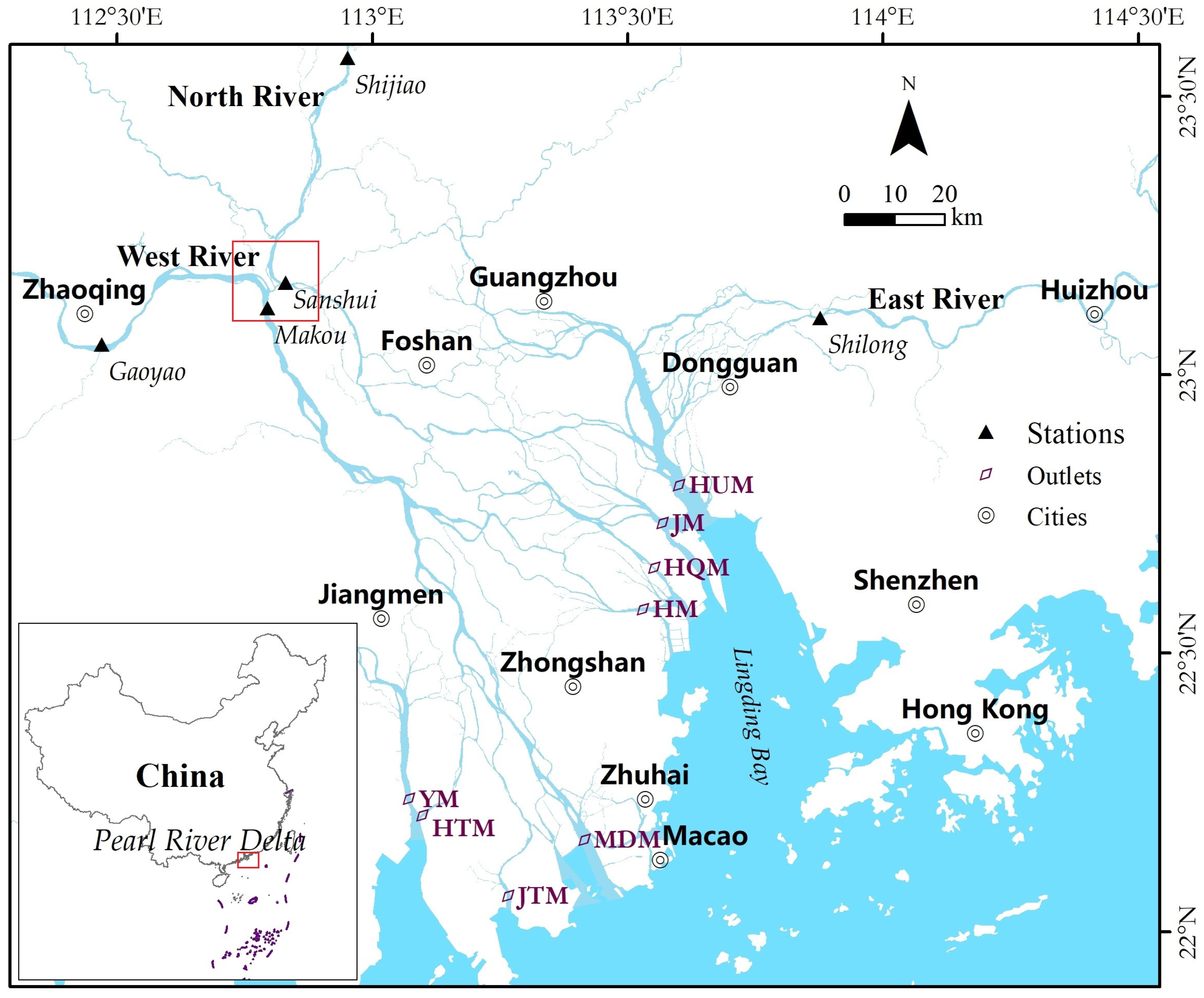

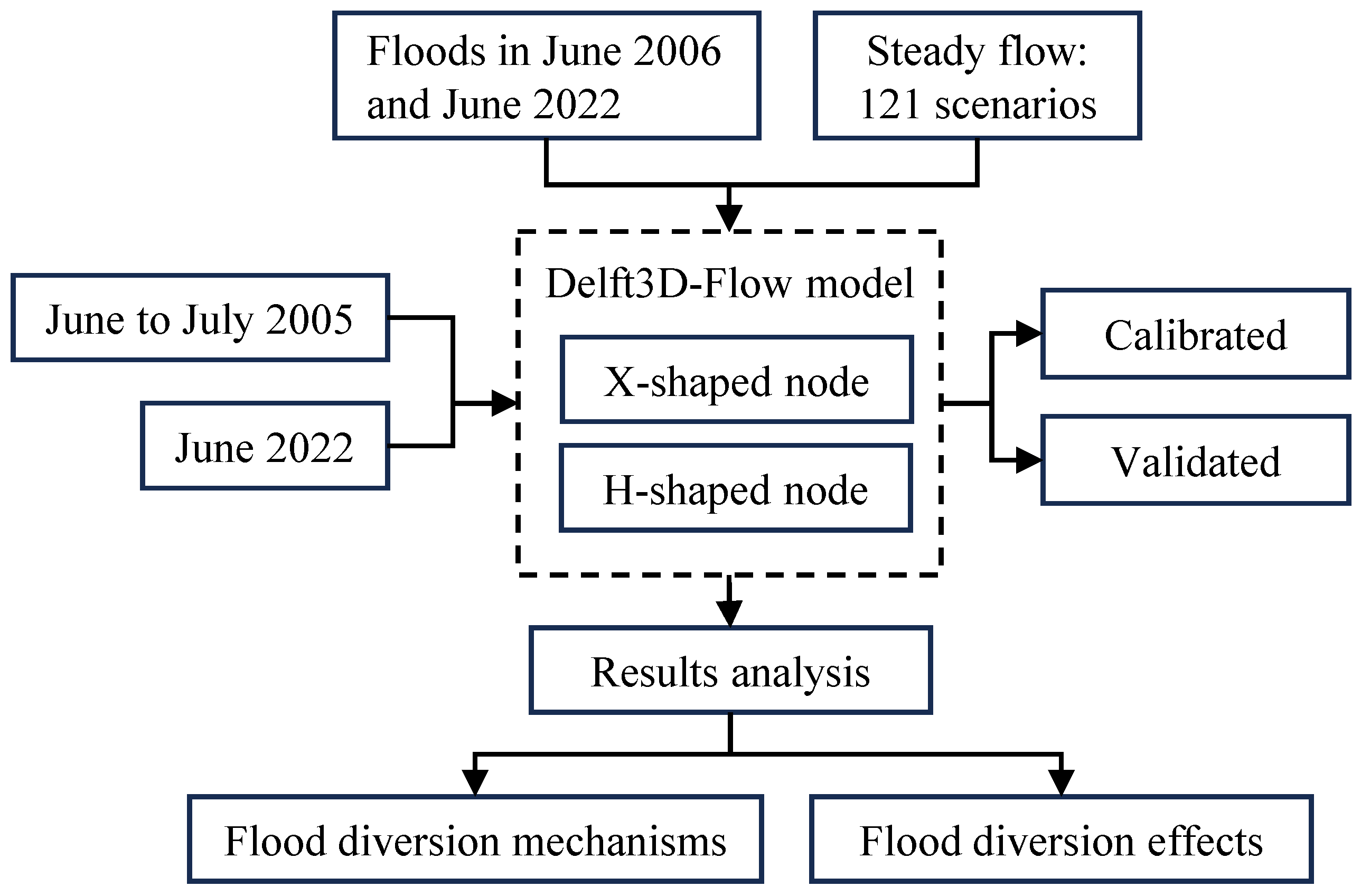

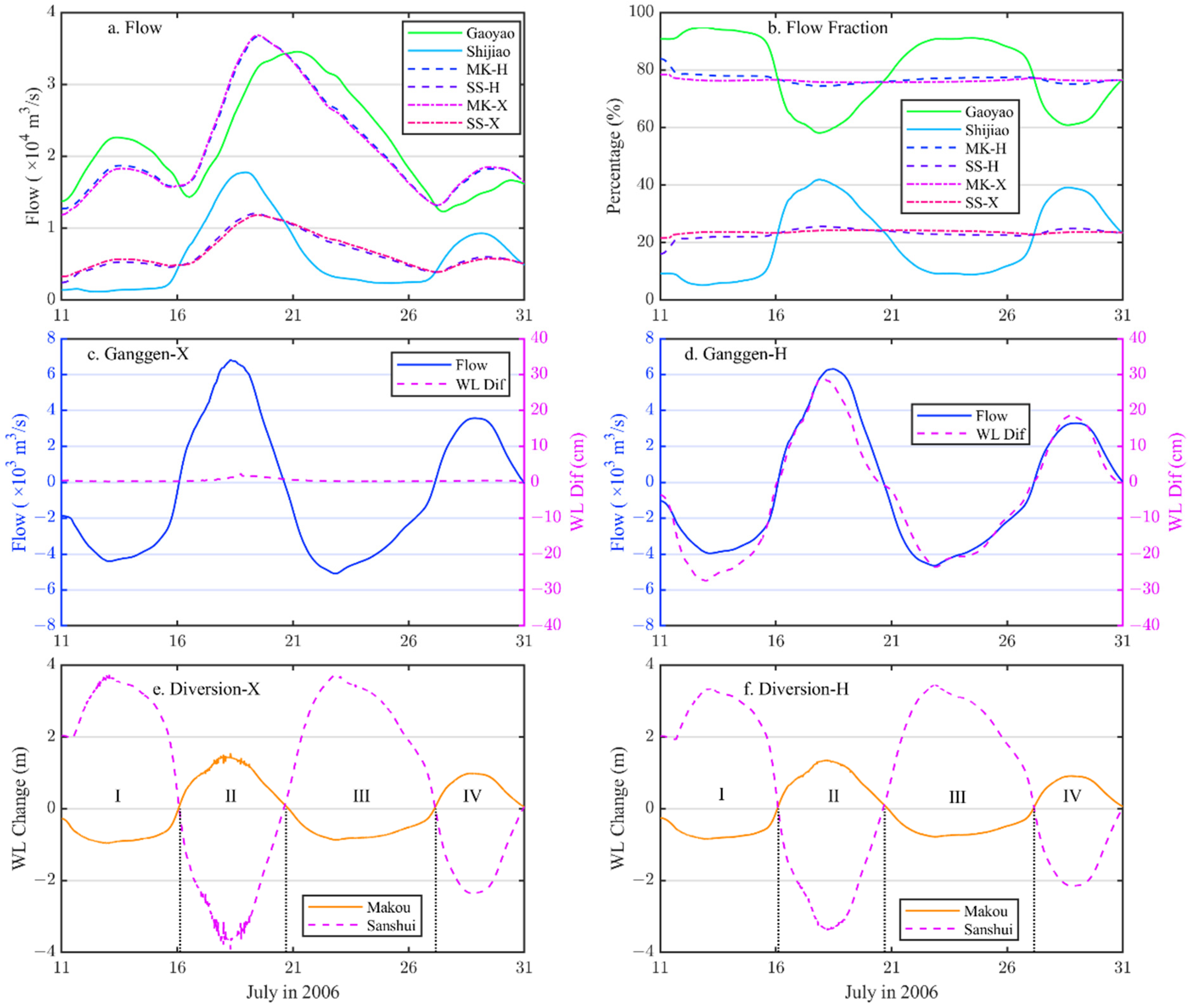
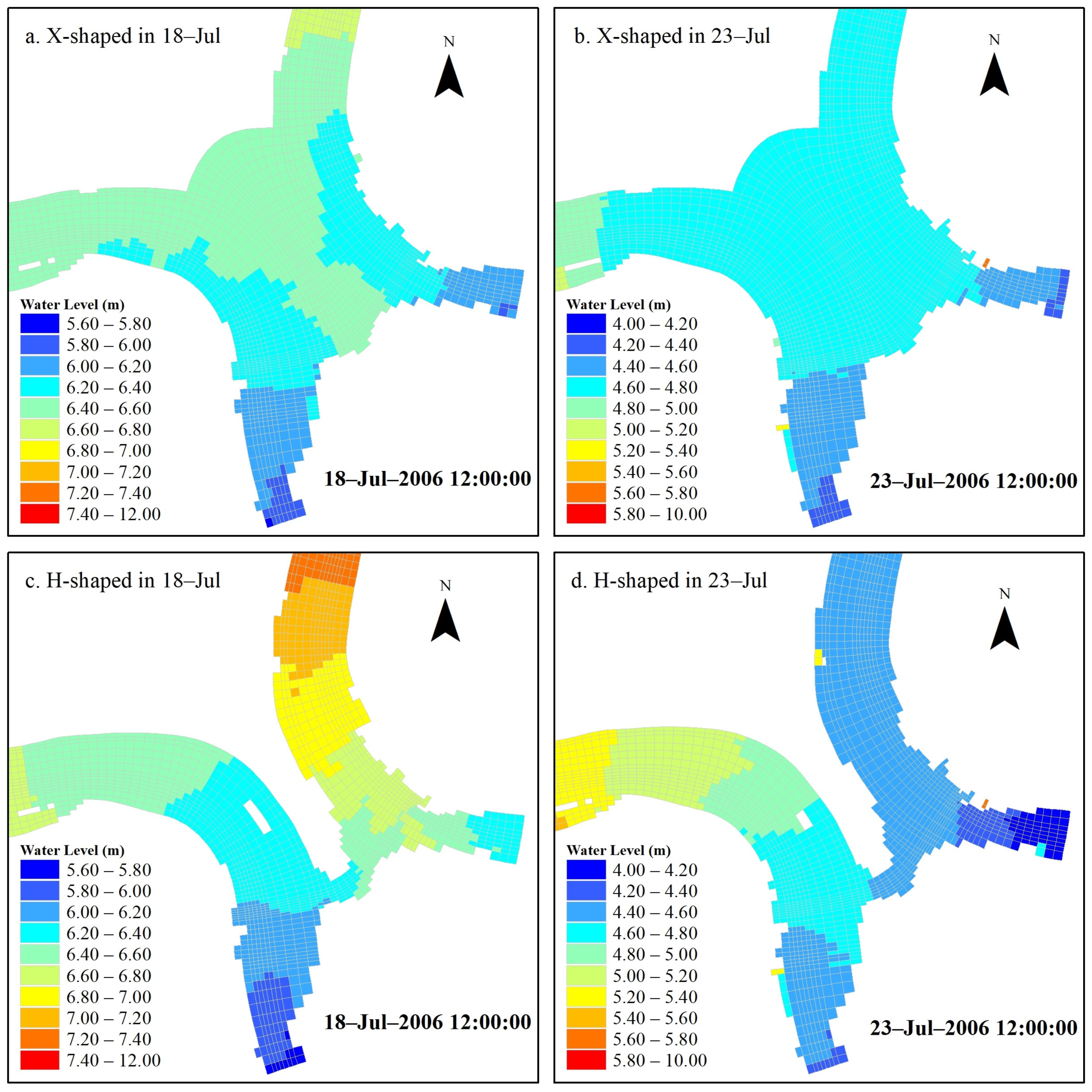

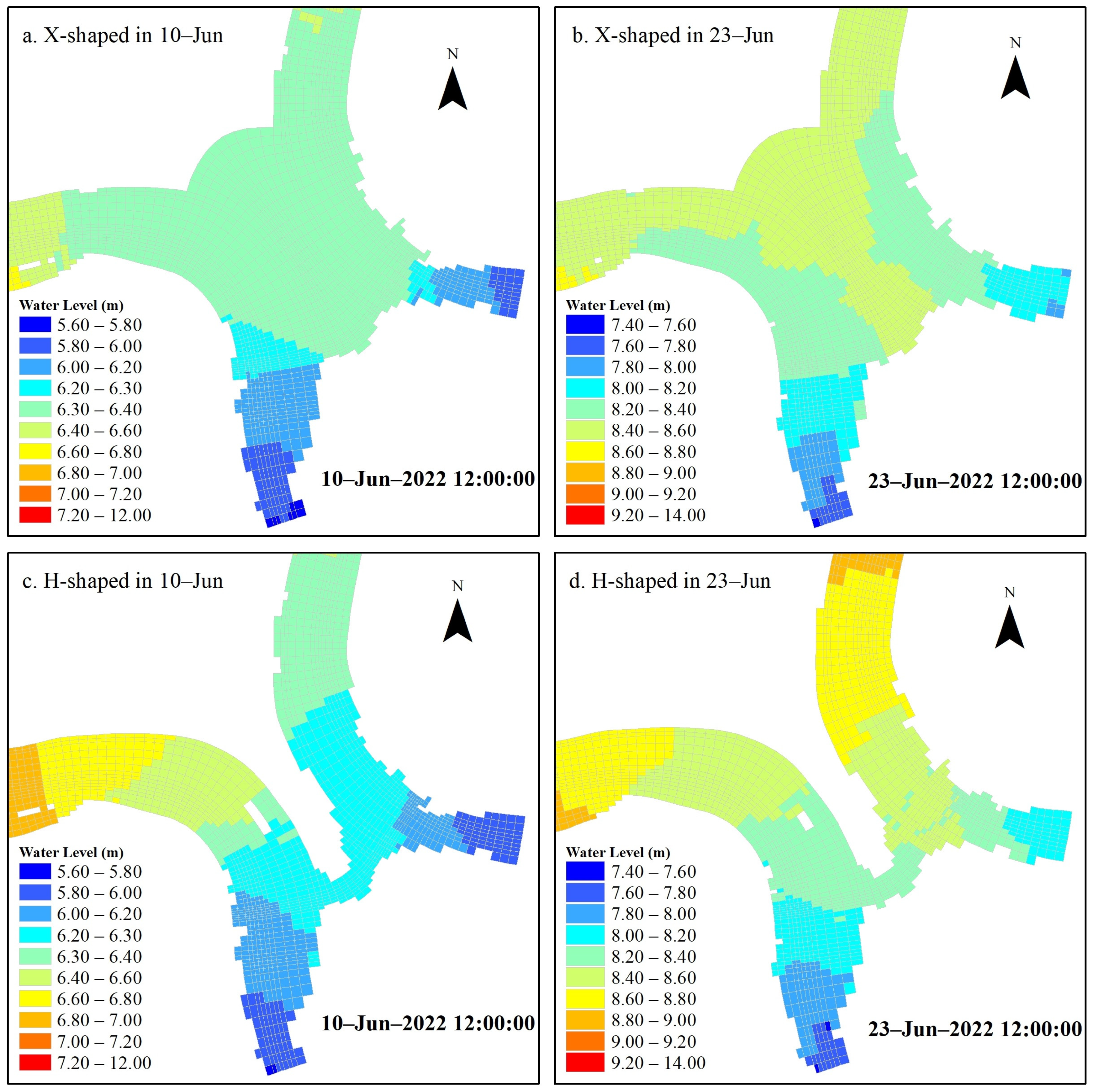
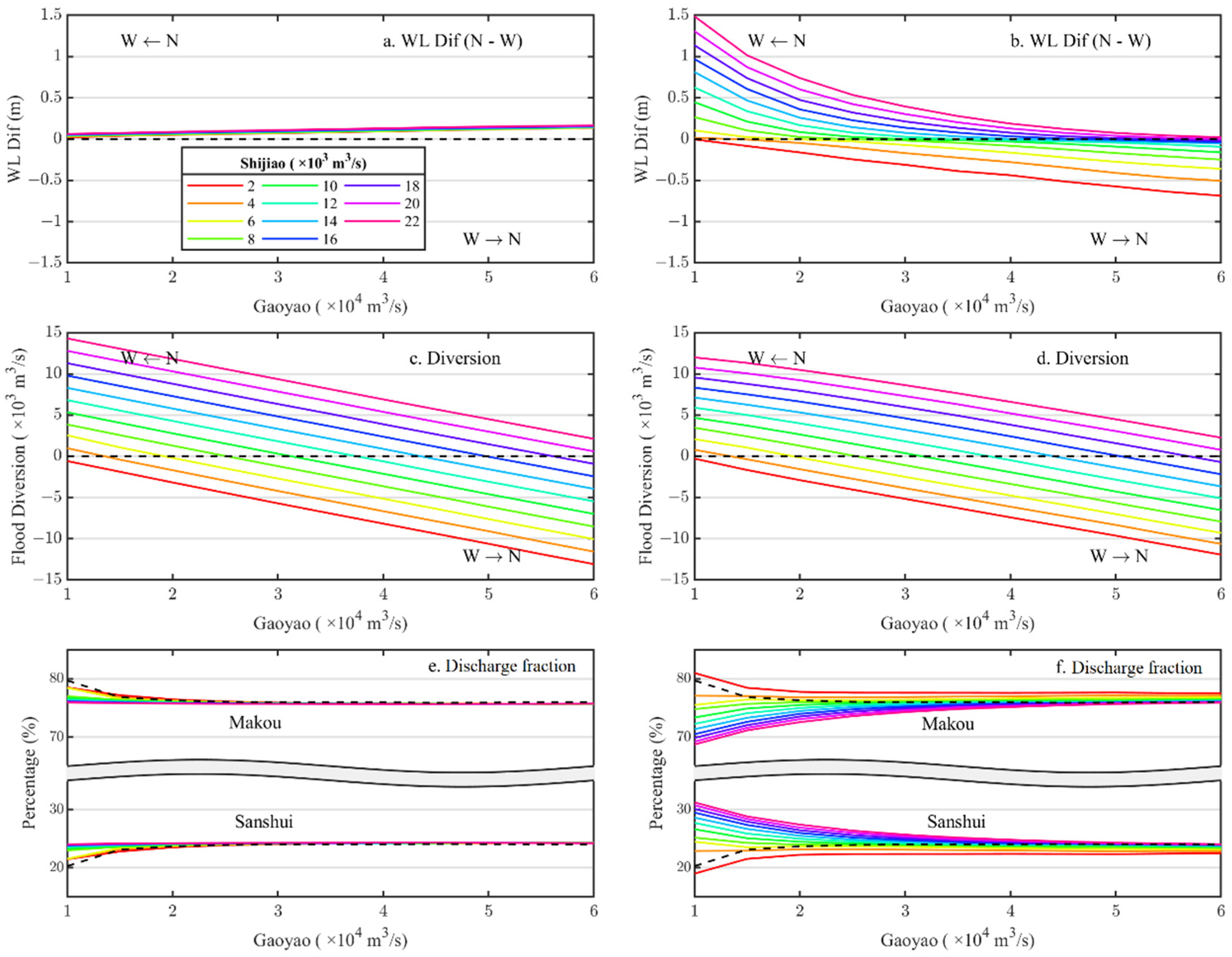

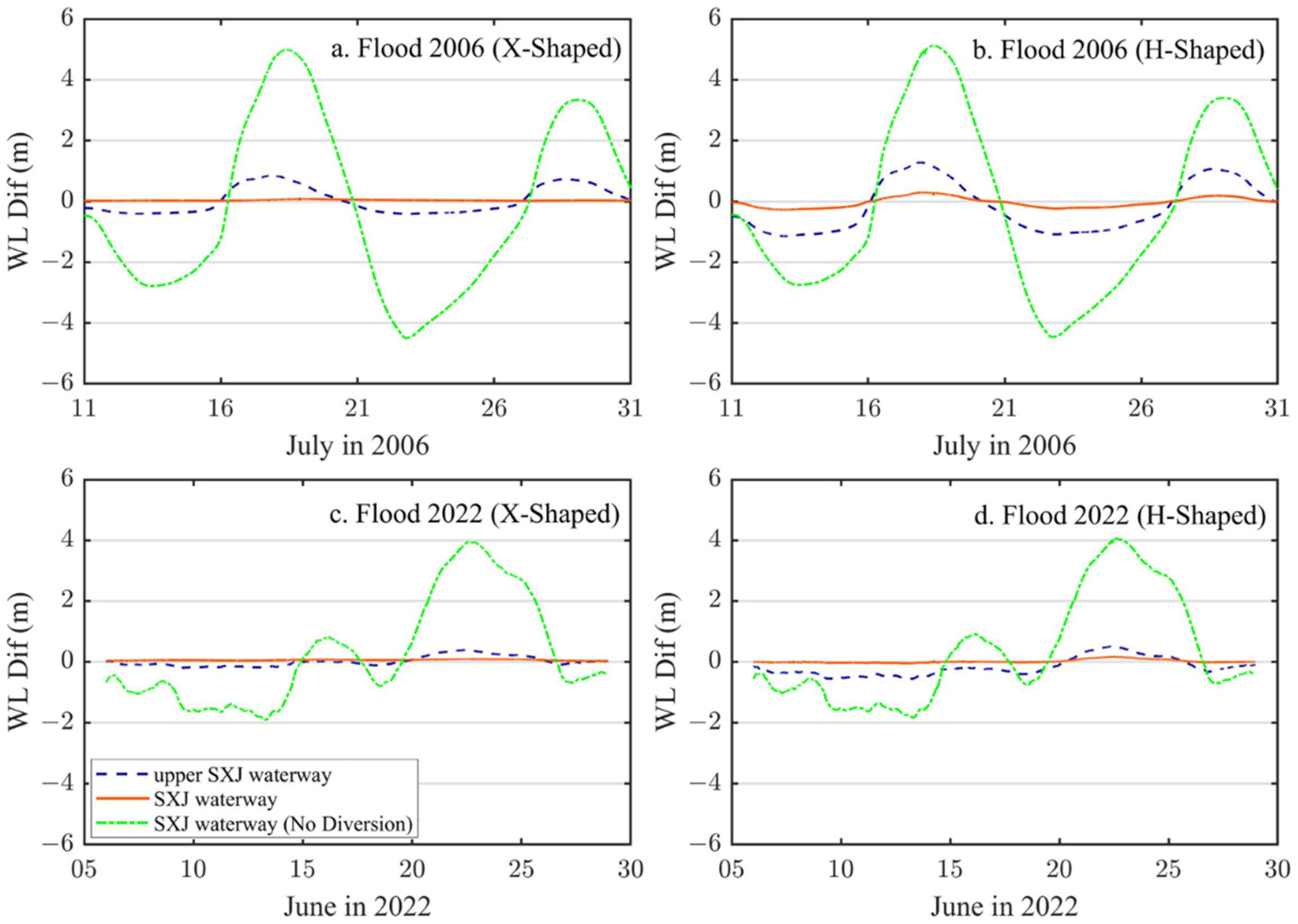
| Rivers/Stations | Flow (×103 m3/s) | ||||||||||
|---|---|---|---|---|---|---|---|---|---|---|---|
| West River (WR)/ Gaoyao | 10 | 15 | 20 | 25 | 30 | 35 | 40 | 45 | 50 | 55 | 60 |
| North River (NR)/ Shijiao | 2 | 4 | 6 | 8 | 10 | 12 | 14 | 16 | 18 | 20 | 22 |
| River/Stations | Return Periods (1:n Year) and Flow Rates (×103 m3/s) | |||||||
|---|---|---|---|---|---|---|---|---|
| 5 | 10 | 20 | 30 | 50 | 100 | 200 | 300 | |
| West River (WR)/Gaoyao | 37.9 | 45.0 | 49.7 | 50.8 | 52.2 | 54.0 | 55.9 | 57.5 |
| North River (NR)/Feilaixia | 11.9 | 13.8 | 15.5 | 16.7 | 17.7 | 19.2 | 20.7 | 21.6 |
Disclaimer/Publisher’s Note: The statements, opinions and data contained in all publications are solely those of the individual author(s) and contributor(s) and not of MDPI and/or the editor(s). MDPI and/or the editor(s) disclaim responsibility for any injury to people or property resulting from any ideas, methods, instructions or products referred to in the content. |
© 2025 by the authors. Licensee MDPI, Basel, Switzerland. This article is an open access article distributed under the terms and conditions of the Creative Commons Attribution (CC BY) license (https://creativecommons.org/licenses/by/4.0/).
Share and Cite
Fang, Y.; Wang, X.; Ren, J.; Liu, H.; Yuan, P.; Ning, Y. Distinct Flood Diversion Mechanisms and Comparable Effects on Discharge Fraction and Peak Water Levels over X-Shaped and H-Shaped Composite River Nodes. Water 2025, 17, 1015. https://doi.org/10.3390/w17071015
Fang Y, Wang X, Ren J, Liu H, Yuan P, Ning Y. Distinct Flood Diversion Mechanisms and Comparable Effects on Discharge Fraction and Peak Water Levels over X-Shaped and H-Shaped Composite River Nodes. Water. 2025; 17(7):1015. https://doi.org/10.3390/w17071015
Chicago/Turabian StyleFang, Yongjun, Xianwei Wang, Jie Ren, Huan Liu, Peiqing Yuan, and Yazhou Ning. 2025. "Distinct Flood Diversion Mechanisms and Comparable Effects on Discharge Fraction and Peak Water Levels over X-Shaped and H-Shaped Composite River Nodes" Water 17, no. 7: 1015. https://doi.org/10.3390/w17071015
APA StyleFang, Y., Wang, X., Ren, J., Liu, H., Yuan, P., & Ning, Y. (2025). Distinct Flood Diversion Mechanisms and Comparable Effects on Discharge Fraction and Peak Water Levels over X-Shaped and H-Shaped Composite River Nodes. Water, 17(7), 1015. https://doi.org/10.3390/w17071015







